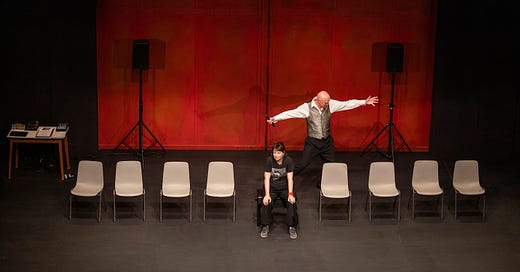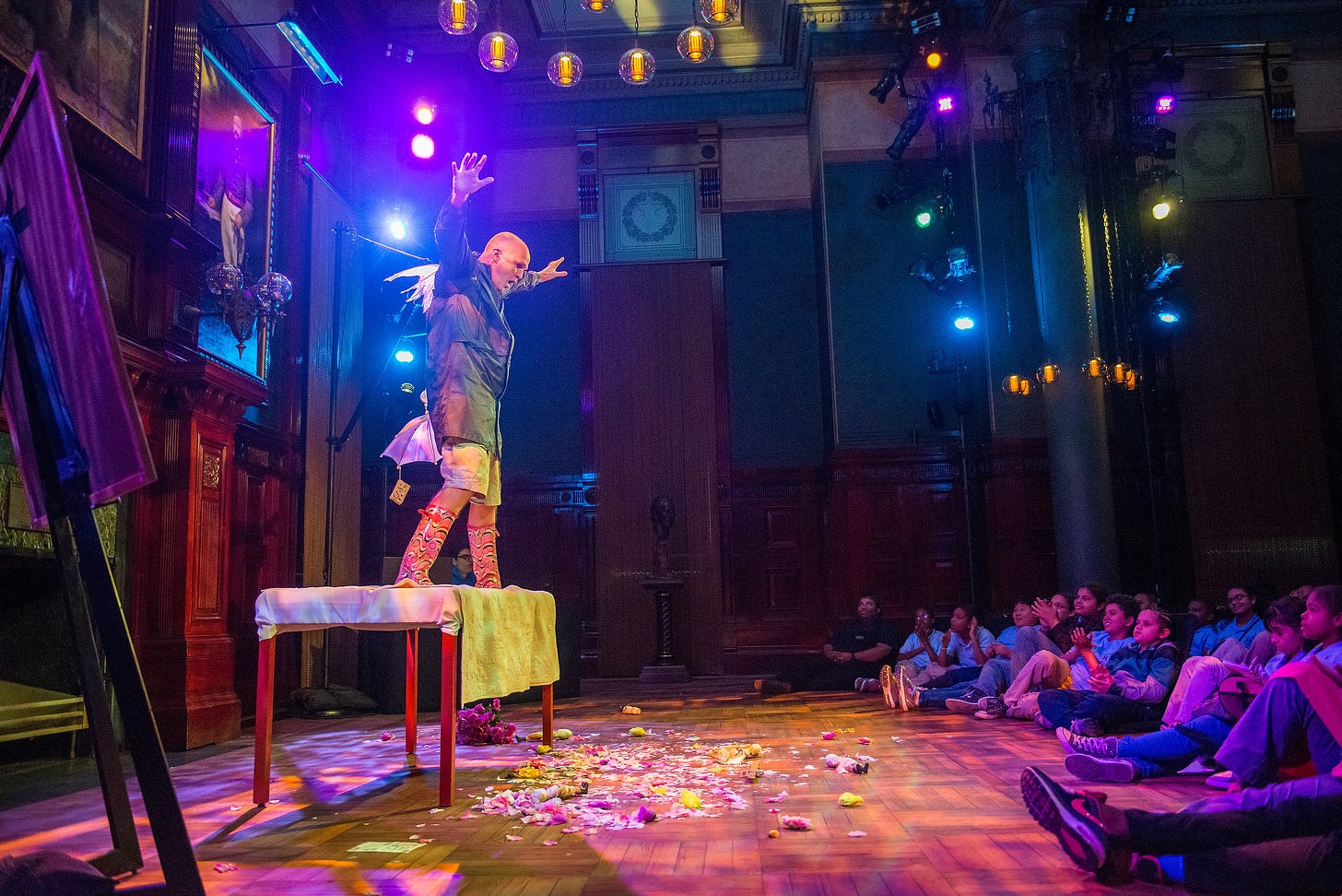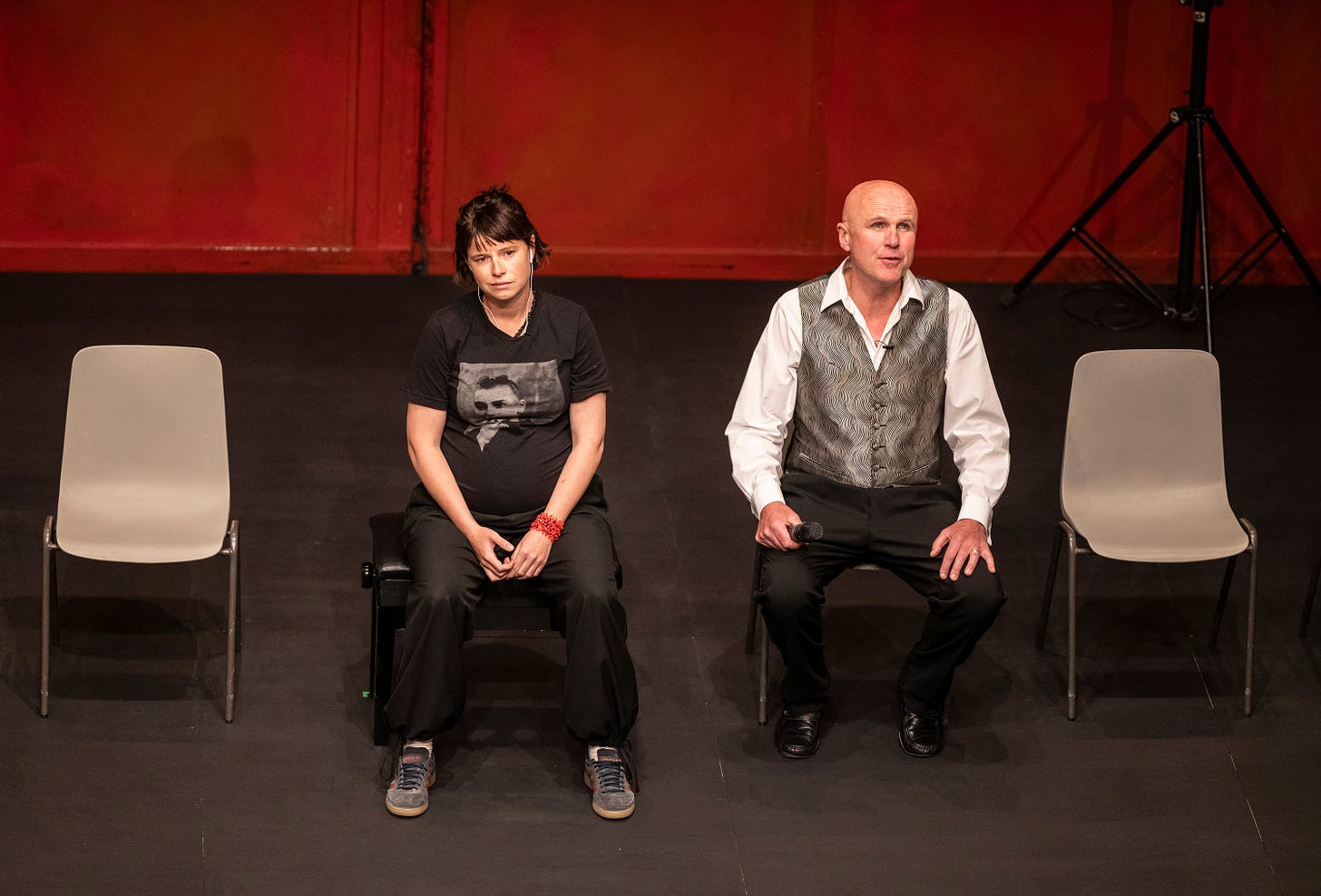Tim Crouch is here to help you see
As An Oak Tree and I, Peaseblossom return, Frey Kwa Hawking traces the line between his work for adults and children
By Frey Kwa Hawking
Twenty years after its debut, at a celebratory anniversary run at the Young Vic, there are still some suggestively varied reviews for Tim Crouch’s An Oak Tree. It tells the simple story of a man who’s lost his daughter and the hypnotist who hit her with his car, but with a different unrehearsed actor playing opposite Crouch every night. Is it eloquent about theatre and grief, or underbaked, emotionally lacking? Is it pretentious or thrilling? Calling the whole notion of art into question? Don’t threaten me with a good time.
May is a big month for Crouch (it’s Crouching season), with revivals of two productions nearly the same age, both starring him. At the end of the month, I, Peaseblossom (which premiered in 2004!) comes to the Royal Shakespeare Company for three days, introducing young audiences to A Midsummer Night’s Dream via a very minor character’s take on things. Crouch’s work for kids also hasn’t escaped some of the same accusations of being too clever for its own good.
Thanks to working at the Unicorn Theatre for some years, I’m most familiar with Crouch’s work for children, and it informs my reading of his work as smiling rather than smirking. Alongside the Traverse, the Unicorn might be the theatre to have shown the most of his shows (including a performance of An Oak Tree starring Roger Lloyd Pack). These two remounts of longstanding productions, one for adults and one for children, in such close proximity prompt the asking: what unites this work, what divides it, and what makes it worth reanimating? I watched An Oak Tree for the first time, and went back over years of Crouch’s work for young people, to think about it.
There’s always been a parallel track of shows for young audiences alongside Crouch’s older work: My Arm debuted in 2003 as he was working on Shopping for Shoes, a show for and about teenagers, shortly after giving up on a PhD on the crossover between teaching and theatre. The son of two English teachers himself, Crouch owns up to a pedagogical bent to some of his work: it’s the ideas which drive the formal invention, rather than something he wants to work out emotionally through the play.
Features I think Crouch’s work for children and adults shares: it’s attuned to the positioning of the audience. It’s tightly scripted yet doesn’t neglect making wise use of all other parts of theatre, like sound design, and the bits around going to the theatre (think the sand-piling interval in Adler and Gibb, which also played at the Unicorn). It has shifting perspectives and is polyphonic, though it doesn’t privilege dialogue over other forms of text.
Though Crouch’s most recent work for adults was the King Lear-telling Truth’s a Dog Must to Kennel in 2022, which utilised an unplugged in VR headset, his most recent work full stop was the wickedly named Toto Kerblammo! (for ages nine and above). Last autumn I spent some time at Crouch’s invitation observing the rehearsal room of Toto Kerblammo!, sitting in the dark listening to a dog describe the sounds of things. First begun at the same time as An Oak Tree, it was commissioned as a kind of live radio play by Visible Fictions back in 2004. A binaural show for ages nine and above, it saws away at isolated 12-year-old Effy’s life from her dog Toto’s perspective as much as hers: he’s emotionally wiser and hears more than her.
In rehearsals, with the actors’ quiet laughs amplified by the headphones while Crouch needed to yell slightly to be heard, there was an unbalanced sense of proximity, like everyone was slightly drunk, trying to aim for each other. Helen Skiera, the sound designer and composer, told me these were the same headphones used by Complicité in The Encounter: 700 at that time were in use by Max Webster’s Macbeth in the West End, while 100 were Toto’s.
I noted down a point where Crouch described the easy physical intimacy between girl and dog to the room as prelapsarian, and was immediately asked to define that. There was a pause as everyone thought about this child and her dog and the before-the-fall easiness of their lolling about together.
“So if you could be a bit more fucking prelapsarian about it next time please...”
I like that Crouch’s work for children is ambitious in form and ideas. The task of Toto is to get Effy allowing other love besides her dog’s into her life at all: hardly cerebral. It doesn’t feel preachy, but that a real victory has been achieved when she can admit to a new (at first annoying) friend that she loves him. Crouch’s younger work delivers the same messages about cruelty and love but sometimes more directly than his adult plays.
Like his older shows, there’s a carefully thought out position for the audience, and it’s immovable. His younger shows are indeed as pedagogical and rigorously structured as his work for adults. He has the utmost respect for the personhood of children, and approaches them as basically the same as adults, expecting much the same of them. I think the shows that aren’t as metatheatrical can sometimes be drier and shoutier than some of his adult work as a result, actually. It’s harder to grist uncertainty in theatre for children, when you can hear crisp packets rustling. Crossing boundaries and confrontation helps with this. He’s working with the same techniques, but a slightly reduced palette.
Crouch is as warm and unsettling in his adult work as he is in his work for younger audiences, but the same precise techniques are put to more existential ends, and have only become sharper since (see The Author, Truth’s a Dog and Total Immediate Collective Imminent Terrestrial Salvation). He’s more able to implicate his adult audience and keep us in discomfort. Still, his work for children is always political, outraged at the disenfranchisement of children and the world they’re inheriting.
Crouch raised his own kids hearing stories and attending Woodcraft Folk camps (“like a left-wing Scouts”), and remembers a Guardian article he wrote (still online with a vintage comment section) which caused a fuss due to his confession that during a really agonising play at Brighton Festival he’d offered one of his sons his phone so they didn't have to watch (“I feared that I was watching my children's love of theatre being robbed from them!”). Nel and Owen are theatremakers in their own right now, so little harm done. Nel makes work for both adults and children herself, while among his collaborations with his father, sound designer Owen has aided and abetted some of Crouch’s Shakespearean work, including I, Peaseblossom.
I, Peaseblossom is one in his series of Shakespearean minor character plays; there’s also I, Malvolio, I, Caliban, I, Cinna, and I, Banquo. What seem to be radical or aslant applications of post-dramatic techniques help to imaginatively situate the audience in the play’s world, working to peel back layers of familiarity or unfamiliarity with Shakespeare’s stories alike. Peel back to what? In I, Peaseblossom, to the vulnerability of being very, very small in a world gone mad with love. Crouch dramatises being a bit part in a play, in a dream, where there’s another play, subject to dream-play logic, and seemingly unable to say anything but the most pathetic lines.
I, Peaseblossom is for ages seven and up, but some things are pitched at his older audience alone: his Peaseblossom has something of the self-righteous man with the world against him often seen in Crouch’s other work. The full gamut of this appeals to us Brits, from Jeremy Clarkson to Stewart Lee. It also lets jokes about coupling, or Oberon sulkily sleeping on the sofa (a line read out by a tiny audience member!), land without fuss.
Seven isn’t too young for how Crouch’s plays recognise and emphasise the semiotic work each show requires of an audience, and text is often the way in. Peaseblossom begins the show blessing things, from those actually occupying the theatrespace (chairs, hairbands, shoes), to unseen things in the world of A Midsummer Night’s Dream (cake crumbs, pool of vomit, broken goblet). As Crouch put it to me, “The focus is on the inside of the audience’s head, often in contradiction to any beautiful pictures onstage. The audience is a co-collaborator, creating a synthesis between the ear and the eye. To close it all off so the stage is immaculately completed, in a way, is not interesting to me.”
There’s an indignant purity to Crouch’s Peaseblossom. It’s a little knowing, a little wistful: he doesn’t want to grow up. “This is meant to be LOVE,” he fumes. “If this is love then I don’t want any of it.” Of course he momentarily falls for an adult audience member, victim to the love-in-idleness flower himself. Children are given place cards from the wedding banquet to assign them characters, as he catches them up with the story of the lovers as he sees it (nonsense from top to Bottom). Like An Oak Tree and several other Crouch shows, I, Peaseblossom is gently reactive within its scripted structure, made from love for Dream even as Peaseblossom expresses his scepticism at the idea of love altogether.
As Peaseblossom, Crouch, now 61 (as he’s updated An Oak Tree to reflect) indignantly repeats “I’m a fairy, I’m a fairy, I’m a fairy” to resist the dreams around him, and makes a point of reminding the audience how to read him: boyish, ethereal, on the verge of tears. The conscious but non-effortful way actors play against type and especially across ages in Crouch’s work feels like a full facing up to how theatre can transform, sometimes gently allowing us to notice what speech and which acts are prescribed according to age. The toe was first dipped there with John, Antonio and Nancy, commissioned for the Royal Court’s Rough Cuts programme in 2010, which saw young actors playing the children of Cameron, Brown and Clegg used as mouthpieces for their fathers’ fatuous words.
That piece was inspired by Tim Etchells’ collaboration with CAMPO (2007’s That Night Follows Day). Crouch actually identifies Forced Entertainment respectfully as a kind of opposite influence, hungering after not just a metanarrative, but a real one. Still, one of Crouch’s more conventionally character-driven plays, Adler and Gibb, features children stage managers making the world around the adult actors. Another, Beginners, gradually replaces its adult actors playing children for child actors, who were previously flitting about, playing a different emotional layer of the narrative, rather than the denotative versions of the characters.
“I hope that releases the young actor from feeling they have to do much, or impersonate much,” Crouch says. “As a performer, I know that if I work too hard then I’m failing in some way, because then I’m owning too much of the performance.”
See also Beginners’ sister play Superglue, written for the youth theatre festival NT Connections, about elderly climate change activists (on a similar theme, the world is heating up and turning upside down in I, Peaseblossom, and Beginners is very concerned with bees). Superglue’s instructions warn explicitly against the creaky use of “mimicry” or “talcum powder” in aging up young actors. Like lots of Crouch’s work, it requires a kind of double-seeing which fails when there's too detailed an attempt at evoking a specific age or gender. It’s about acting doing something other than an attempt at televisual detail, “virtuoso and separate from an audience,” Crouch says.
“So Truth’s a Dog is a good one: by putting on that headset, the deal is that neither of us can see, really, but we'll generate the images and we’ll do it together. My job is to help you see. My transitive verb always seems to be directed towards the audience – without the actor adopting a gross act of interpretation."
Acting but resisting that gross act of interpretation is made a point of in An Oak Tree, probably Crouch’s defining show for many. Its first week of performances in the Young Vic’s main house include Adjoa Andoh, David Tennant, Indira Varma and Russell Tovey. The actor playing with him on press night is Jessie Buckley, who has to be entirely ignorant of the show before signing up, and is fed lines by Crouch directly or given scraps of script as he guides her and us through the story. We read Buckley as grieving father Andy both despite and with her six-months-pregnant bump, a lovely further highlighting of the eating of difference theatre can do.
So, if you can afford the twentieth anniversary ticket prices, why should you watch An Oak Tree, after all this time?
I wish I hadn’t read it years before this, though it’s hard to envision on the page, shifting back and forth through actors and characters. I still respond physically when Buckley first reveals she’s the father of the dead girl to Crouch’s hapless hypnotist, but I’m jealous of my boyfriend, who knows nothing about the show prior to seeing it and without recognising who Buckley is, is ambushed by the trust that’s constructed in front of him, crying silently and furiously throughout.
Meanwhile I’m most drawn to how Crouch decides what instructions he lets us hear, how visible he makes directing and constructing theatre to us. You can do it like this: it can be this bare. There’s an inherent mix of calculating and innocence Crouch has which he utilises well here and elsewhere as a performer. Pity is an edge which cuts both characters.
It’s interesting that in on RSC podcast Interval Drinks, Crouch calls theatre a “dematerialised art form”, something pure, impossible to commodify: Truth’s a Dog is, among other things, very concerned with whether this is true. Crouch also uses ‘dematerialisation’ to refer to his non-representational, minimalist stagecraft approach – no wonder he was drawn to Michael Craig-Martin’s An Oak Tree, the inspiration for his own Oak Tree in the first place. Crouch is fond of this word: ‘dematerialisations’ is also the term used in Adler and Gibb to describe the artist Janet Adler’s destroying of her own work.
Crouch has a clear-eyed appreciation for acting as a tool rather than an end in and of itself; it’s ironic but understandable that years ago An Oak Tree became a great showcase and refreshing challenge for stars. It’s an attractive programming choice in this time of austerity for the arts, though when Crouch tells Buckley that apart from every word being scripted, she’s otherwise free, a reviewer behind me hisses “You’re not free, you’re very expensive!”
Before the show starts, I spot Toby Jones in the audience. I know he can’t be the second actor tonight: as an established Crouch collaborator, he’s done it already. While watching he must remember his turn. I wonder if it’ll run out of actors unspoiled for it, if young actors will declare their ambition by refusing to see it. I wonder too if An Oak Tree will run out of reviewers who don’t watch it through the memory of a past performer (but they’re always making more who haven’t seen it yet, like me). This is how we watch the classics, through thickened lenses.
Having seen it now, I wonder if it’s too immaculate, eating everything. It turns every awkwardness, every performance, into grief, into the suspicious process of role-ing (as opposed to de-roling), and it’s transfixing. It just about counters the commodification-force of its star casting: its intricate design means it can’t fail. And the bare bones of how it’s made are impressive enough to justify its return, even if its mystique and casting helps in guaranteeing audiences.
If Tim plays this show for another twenty years, I hope we keep turning up for his new work alongside it, regardless of age guidance. His younger shows often take as much thinking as his work for adults, and are likely to move you as much: good and thoughtful children’s theatre makes us, as well as the world.
An Oak Tree is at the Young Vic, London to 24 May. I, Peaseblossom is at the RSC, Stratford-upon-Avon, 28 to 31 May












